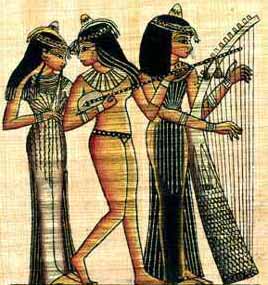The people of Egypt lived a merry life finding time for leisure, music, and dance. The Egyptian Music and singing in the life of Egypt had considerable attention since the 1st Dynasty, 3000 BC. Scenes in temples and tombs showing musicians playing indicate that music played a vital role in their social life. More information on Ancient Egypt Music
Egyptians had a polytheistic religion; they worship an innumerable number of gods and goddesses. Worship of God is naturally associated with music. There were even gods specifically associated with music, such as Hathor and Bes. Egyptian Music had a central role in religious rituals, hymns, and prayers.
Mistress of Egyptian Music

One of Hathor’s titles was “mistress of music” and she was considered the goddess of singers. Bes was often depicted playing instruments. Music found its way into many contexts in Egypt: temples, palaces, workshops, farms, battlefields and the tombs.Perhaps the highest status belonged to temple musicians; the office of “musician” to a particular god or goddess was a position of high status frequently held by women. Musicians connected with the royal household were held in high esteem, as were certain gifted singers and harp players.
Professional musicians were well paid and most were women. Somewhat lower on the social scale were musicians who acted as entertainers for parties and festivals, frequently accompanied by dancers.
Musical instruments ranged from very simple, such as percussion instruments, to very complex, such as harps. The simplest instruments were human hands. Clapping was depicted on many walls as being a large part of most musical performances.
Drums were also popular. Musical instruments include Barrel drums, clappers, Cymbals, Trumpet, type of oboe, pipes, Clarinet, flute, harp etc. But details of Egyptian notes and composition are unknown to us.A wide range of musical instruments was formed and several advancements in music were achieved during the Middle Kingdom which continued in the New Kingdom. Both male and female voices were enjoyed in Egypt. Music was based on a scale of 5 tones without halftones. This fact can be concluded from the position of holes on flutes.
Various titles provide some information on musician’s social organization. The best documented of these were referred to “hnr”. They sang and danced in temples, palaces, and funerary settings. This type of group flourished from about 2500 through 1500 BC and during the Ramessid Period. Egypt’s music later was greatly influenced by the Arab tradition.
